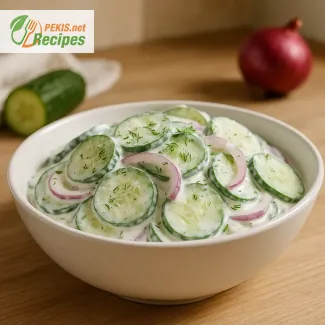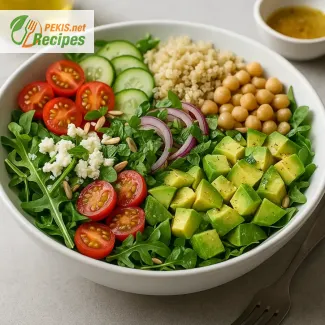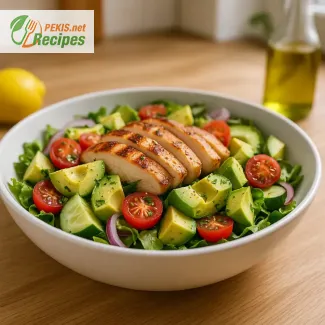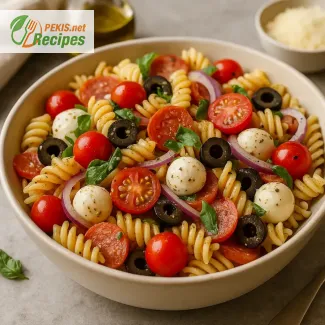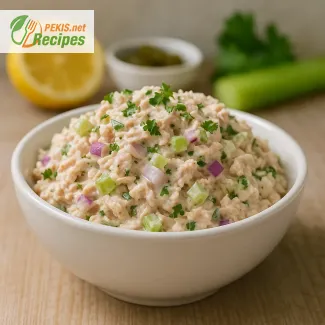
The Ultimate Guide to Making the Perfect Creamy Tuna Salad
Discover how to make a quick, protein-rich classic in just 10 minutes
Tuna salad has long been a go-to comfort dish in countless households around the world. Its popularity lies in its versatility, ease of preparation, and the satisfying balance between creamy texture, bright acidity, and the umami richness of quality canned tuna. Whether enjoyed as a sandwich filling, a lettuce wrap, or a hearty topping for crackers, this dish remains a staple in both everyday meals and spontaneous gatherings.
What sets this creamy tuna salad apart from others is its ideal balance of flavors: tangy, salty, creamy, and slightly sweet. Achieving that harmony doesn't require expensive ingredients or hours in the kitchen—just the right combination of fresh components and a little attention to texture. In this recipe, the tuna takes center stage, enhanced by crisp vegetables, smooth mayonnaise, and just a hint of mustard or lemon juice to bring it all together.
Why this recipe works for busy lifestyles
Time constraints often make people settle for bland meals or unhealthy options. That’s where this recipe shines. You can prepare it in under 10 minutes using ingredients that are likely already in your pantry or fridge. It's a reliable option for meal prepping, quick lunches, or a spontaneous dinner when cooking from scratch isn't feasible.
The simplicity of this dish doesn't compromise its flavor. Each bite offers a pleasing contrast in textures—the creamy dressing against the chunkiness of the tuna, the crunch of celery or red onion, and the slight tartness that cuts through the richness. Add to that the fact that it can be stored for a couple of days and gets even better after resting, and you’ve got a meal prep champion.
Choosing the right ingredients for optimal taste
The base of any great tuna salad begins with high-quality canned tuna. Solid white albacore or skipjack varieties packed in water or oil offer different flavor profiles—choose based on your preference for richness or lightness. The type of mayonnaise matters too. A full-fat, creamy mayo will deliver a smoother texture, while a lighter version may reduce calories without sacrificing too much flavor.
Crunch and freshness are key. Use freshly chopped vegetables like red onion, celery, or pickles to give the salad dimension. Optional additions like hard-boiled eggs, Dijon mustard, or a dash of vinegar can elevate the complexity without overwhelming the base flavors.
Tips for customizing your tuna salad
Tuna salad adapts easily to various dietary needs and preferences. For a lighter variation, try substituting half of the mayonnaise with Greek yogurt. Adding chopped apple or grapes provides a sweet contrast, while capers, olives, or fresh herbs can give it a Mediterranean twist.
If you're preparing this salad for sandwiches, make sure to choose bread that complements the filling—sourdough, rye, or toasted brioche all work beautifully. For a low-carb option, serve it in lettuce wraps or over a fresh salad bowl with cherry tomatoes and cucumbers.
Storage and serving suggestions
Tuna salad is best when slightly chilled, making it a perfect dish to prepare ahead of time. Store it in an airtight container in the refrigerator, where it will stay fresh for up to three days. The flavors will continue to meld over time, often improving after a few hours of rest.
For gatherings or picnics, consider presenting the tuna salad in a bowl surrounded by various accompaniments: crackers, toasted baguette slices, or vegetable sticks. This allows guests to build their own snack-sized portions, making it ideal for informal entertaining.
Whether you're seeking a quick lunch, a protein-rich snack, or an easy dish for a casual brunch spread, this classic tuna salad delivers every time—fresh, creamy, and endlessly adaptable.
Step 1: Drain the canned tuna thoroughly and transfer it to a medium-sized mixing bowl. Use a fork to gently break up the chunks without mashing the texture.
Step 2: Add mayonnaise, Dijon mustard, and lemon juice to the bowl. Mix gently until the tuna is evenly coated and creamy.
Step 3: Fold in finely chopped red onion and celery. Stir until all ingredients are well combined. Add salt and black pepper to taste.
Step 4: Optionally, stir in chopped parsley or pickles for added freshness and flavor.
Step 5: Chill in the refrigerator for 10–15 minutes before serving to allow flavors to blend.
Serving suggestions:
Serve chilled as a sandwich filling, in lettuce wraps, on crackers, or over a fresh green salad.
Creative Ways to Elevate Your Homemade Tuna Salad
Expert tips for making this creamy classic even more delicious and nutritious
Homemade tuna salad has become a timeless staple for quick lunches, healthy snacks, or picnic-ready meals. While the traditional recipe is satisfying on its own, there are many creative variations and upgrades that can bring new depth, texture, or nutrition to the dish. Whether you're aiming to boost its health profile, enhance its flavor complexity, or simply avoid common preparation mistakes, a few thoughtful changes can make all the difference.
Use premium ingredients for better taste and texture
The base of any great tuna salad is high-quality canned tuna. Choose varieties labeled as solid white albacore or chunk light skipjack, depending on whether you prefer a milder or more robust fish flavor. Tuna packed in extra-virgin olive oil tends to offer a richer texture and mouthfeel, while tuna in water is lighter and works well in low-fat diets.
A good tuna salad also benefits from fresh produce. Ingredients like finely chopped celery, red onion, or even grated carrots add both crunch and natural sweetness, balancing the creaminess of the dressing. For a zesty kick, try adding capers, dill pickles, or a spoonful of whole-grain mustard.
How to balance creaminess without overpowering
One of the most common issues with tuna salad is an overly heavy or greasy texture. Instead of relying solely on mayonnaise, experiment with adding Greek yogurt, low-fat sour cream, or avocado. These substitutions not only reduce saturated fat but also offer a tangy brightness or buttery smoothness.
If you enjoy a bolder profile, incorporate lemon zest, a splash of apple cider vinegar, or a pinch of smoked paprika. These small touches add complexity and help balance the richness of the creamy base without overwhelming the core flavors.
Customize for dietary needs and preferences
Tuna salad is naturally gluten-free, but it's also easy to adjust for specific dietary goals. To increase fiber and reduce calories, substitute half the mayonnaise with mashed avocado or plain Greek yogurt. For a high-protein variation, fold in chopped hard-boiled eggs or use a higher ratio of tuna to dressing.
You can also experiment with add-ins like cooked quinoa, chickpeas, or roasted bell peppers to turn the salad into a more substantial meal. These ingredients not only increase nutritional value but also add pleasant texture contrasts.
Health-conscious swaps with flavor in mind
While traditional mayonnaise is rich and familiar, it can be replaced or reduced with healthier alternatives. A popular option is using olive oil-based mayo, which has a more favorable fat profile. You can also prepare your own light dressing using mustard, yogurt, lemon juice, and herbs.
Adding fresh herbs such as parsley, dill, or chives brings a vibrant, aromatic element to the salad, making it feel lighter and fresher. Herbs also provide beneficial antioxidants and phytochemicals.
If you’re watching sodium intake, be cautious with ingredients like pickles, capers, and store-bought mayo, which can significantly increase the salt content. Opt for low-sodium tuna and taste before adding extra salt.
Common mistakes to avoid when making tuna salad
One frequent misstep is overmixing the salad, which can result in a mushy texture that feels heavy. To maintain structure and visual appeal, mix gently and fold in ingredients instead of stirring vigorously.
Another mistake is using tuna that’s too watery. Always drain canned tuna thoroughly, especially if it’s packed in water. Excess moisture can water down the dressing and make the salad soggy.
Many people also skip the resting step. Letting the salad chill for at least 10–15 minutes allows the flavors to meld and the texture to stabilize, which enhances both taste and presentation.
Why homemade always wins
When made at home, tuna salad offers greater control over ingredient quality, nutrition, and taste. You avoid the preservatives and added sugars often found in store-bought versions and can tailor the recipe exactly to your preferences. Plus, preparing your own version encourages mindful eating and a closer connection to the food you serve.
Beyond health benefits, the versatility of this dish makes it ideal for every season. In summer, pair it with fresh tomatoes and cucumber; in winter, serve it warm over a baked potato or toast. With a few thoughtful tweaks, even a simple tuna salad can become a signature dish that reflects your own culinary style.
Allergens present in the recipe:
- Fish (tuna)
- Eggs (mayonnaise may contain eggs)
- Mustard (Dijon mustard)
Contains gluten: No (gluten-free)
To remove allergens:
- Replace mayonnaise with egg-free vegan mayo to eliminate eggs.
- Omit or substitute mustard with lemon zest or a small amount of vinegar.
- Always check canned tuna and condiment labels for traces of allergens.
Vitamins and minerals per serving (approximate):
- Vitamin B3 (Niacin): 8 mg – Supports energy metabolism and brain function
- Vitamin B12: 2.4 µg – Essential for nerve health and red blood cell formation
- Vitamin D: 2.5 µg – Supports bone health and immune function
- Iron: 1.2 mg – Vital for oxygen transport in the blood
- Magnesium: 22 mg – Helps regulate muscle and nerve function
- Selenium: 44 µg – Acts as an antioxidant and supports thyroid health
- Phosphorus: 180 mg – Important for bone and teeth structure
Antioxidants per serving (approximate):
- Selenium: 44 µg – Protects cells from oxidative stress
- Vitamin E: 1.5 mg – Supports immune function and protects cell membranes
- Polyphenols (from parsley and celery): ~30 mg – Help reduce inflammation and promote cardiovascular health

